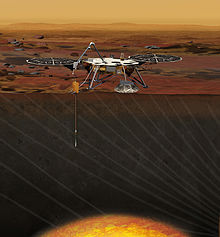The next mission to Mars includes plans to explore beneath the planet’s surface. The plan is called InSight and is scheduled for launch in 2016. The goal is to collect information on the crust, mantle and core of Mars to determine how the planet has evolved. This should enhance any knowledge that is gained from Curiosity’s surface exploration.
From Science:
$425 million lander that would drill a few meters into Mars in order to probe its crust, mantle, and core will be NASA’s next major planetary science mission. In a teleconference late Monday, NASA’s associate administrator for the Science Mission Directorate, John Grunsfeld, announced that he has selected the InSight mission to Mars as NASA’s next cost-capped mission to explore the solar system. The craft will set a seismometer on the surface and send a temperature sensor down a drill hole to better understand how that rocky planet evolved from a nascent ball of magma.
InSight (Interior Exploration Using Seismic Investigations, Geodesy, and Heat Transport) beat out two other finalists for NASA’s Discovery Program award. One would have splashed a craft onto a lake of liquefied natural gas on Titan, and another would have touched down on an active comet. InSight team members, led by planetary scientist W. Bruce Banerdt of NASA’s Jet Propulsion Laboratory in Pasadena, California, had made a strong pitch for their mission quickly returning the maximum science for the buck. InSight is based on the lander and spacecraft design that successfully delivered the Phoenix lander to Mars, they noted, which reduces both cost and risk. And while seismological studies have detailed Earth’s interior, the interiors of the three other rocky planets—Mercury, Venus, and Mars—have remained largely unknown. Mars, they argued, is large enough to have separated into crust, rocky mantle, and metallic core, but it has not been so tectonically active that it erased the record of that evolution.
